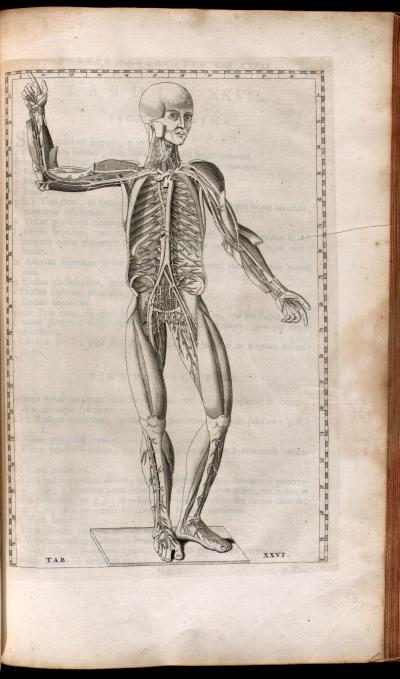|
|
| ALBINI, Bernardi Siegfried
|
| Eustachi/Tabulae Anatomiae
|
| Leiden: Langerak and Verbeek, 1744
|
|
|
| First edition thus.
|
| Folio (386 x 253 mm)
|
| Contemporary sheepskin, gilt spine.
|
|
|
|
|
|
|
|
|
|
|
|
|
|
Bartolomeo Eustachi was one of the most important anatomists of the 16th century (remembered today for his identification of the Eustachian tubes) but his published work was limited. Most significantly, a group of anatomical engravings (and accompanying commentary) that he made were left unpublished at his death because he feared excommunication from the Catholic Church for his dissections (see Vesalius ). They remained unpublished until the 18th century, when they were recovered (without the commentary) and printed at Leiden in 1714. At that point it was realized that Eustachi had been an anatomical pioneer of the same stature as Vesalius and, had the plates been published in his own time, anatomical science would have been greatly accelerated.
|
|
|
|
In 1744 the esteemed Leiden anatomist Bernard Albinus wrote his own explanatory text to the engravings, recut the plates, and made outline copies of each figure so that he could label features without cluttering up the original images. He also devised a very clever scheme of graphical coordinates along the horizontal and vertical axes of each plate so that he could reference features by location.
|
|
|
|
Whereas Vesalius drew his figures directly from individual cadavers with the intent of exactly representing its particular features, Eustachi distilled his many observations into what are clearly idealized forms of the human body. One can thus consider Vesalius more of an Aristotelian dedicated to studying nature by direct observation and example, while Eustachi appears as a Platonist searching for the true form behind the individual exemplars. This dichotomy represents a philosophical divide in natural science, with the Aristotelians criticizing the Platonists for injecting too much theory into their observations, while the Platonists fault the Aristotelians for injecting too little.
|

|
|
|
|
|
|
from Bernardi Albini, Eustachi/Tabulae anatomiae, Leiden 1744.
|

